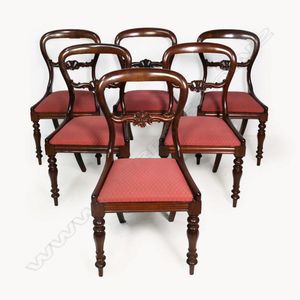Victorian Balloon Back Dining Chairs in Dark Salmon Pink
A set of six Victorian balloon back dining chairs, turned legs, drop in seats upholstered in a dark salmon pink fabric.
You must be a subscriber, and be logged in to view price and dealer details.
Subscribe Now to view actual auction price for this item
When you subscribe, you have the option of setting the currency in which to display prices to $Au, $US, $NZ or Stg.
This item has been sold, and the description, image and price are for reference purposes only.
- Turned Legs - are legs which have been turned on a lathe. In use from the 16th century, turned legs on tables, chairs and cabinets became more frequent until, by the 1830s, the Georgian square or tapered leg was rarely found except in country pieces.
- Victorian Period - The Victorian period of furniture and decorative arts design covers the reign of Queen Victoria from 1837 to 1901. There was not one dominant style of furniture in the Victorian period. Designers used and modified many historical styles such as Gothic, Tudor, Elizabethan, English Rococo, Neoclassical and others, although use of some styles, such as English Rococo and Gothic tended to dominate the furniture manufacture of the period.
The Victorian period was preceded by the Regency and William IV periods, and followed by the Edwardian period, named for Edward VII (1841 ? 1910) who was King of the United Kingdom and the British Dominions and Emperor of India for the brief period from 1901 until his death in 1910. - Turning - Any part of a piece of furniture that has been turned and shaped with chisels on a lathe. Turned sections include legs, columns, feet, finials, pedestals, stretchers, spindles etc. There have been many varieties and fashions over the centuries: baluster, melon, barley-sugar, bobbin, cotton-reel, rope-twist, and so on. Split turning implies a turned section that has been cut in half lengthwise and applied to a cabinet front as a false decorative support.
- Drop in Seat - Mostly used on Regency upright chairs, a drop in (or "drop on") seat is an unsprung removable seat where the upholstery is attached to a wooden frame, which is held in place by the sides of the chair, and usually a wooden peg at the front of the chair. An inset upholstered seat is of the same construction, but it sits within a frame whose perimeter includes four sides of the chair.
Because the upholstery frame was not very deep, the seats were relatively uncomfortable. In the mid 19th century coiled upholstery springs came into use and frame of the chair was used as the upholstery frame, making for a much more comfortable and responsive seat.
This type of seat was known as an over-upholstered or over-stuffed seat.
This item has been included into following indexes:
-
chairs, sets of 6, style or period
- balloon back 83
- Victorian 218
- chairs, sets of 6, timber - all styles and timbers 747
